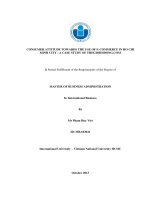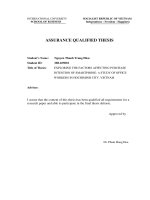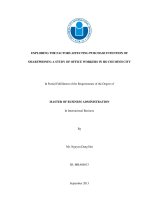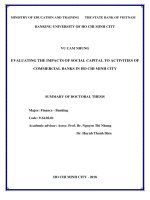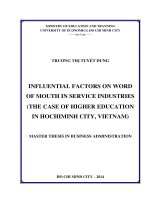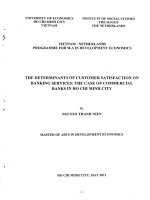Factors affecting the decision of using internet banking services of individual customers in ho chi minh city
Bạn đang xem bản rút gọn của tài liệu. Xem và tải ngay bản đầy đủ của tài liệu tại đây (1.46 MB, 71 trang )
Instructor: MSc. Tran Kim Long
MINISTRY OF EDUCATION
AND TRAINING
Author: Nguyen Huynh Duc
STATE BANK OF VIETNAM
BANKING UNIVERSITY OF HO CHI MINH CITY
BACHELOR’S THESIS
FACTORS AFFECTING THE DECISION OF
USING INTERNET BANKING SERVICES
OF INDIVIDUAL CUSTOMERS
IN HO CHI MINH CITY
Author: Nguyen Huynh Duc
Class: HQ2 – GE03
Student code: 030630141727
Instructor: MSc. Tran Kim Long
HO CHI MINH CITY, 01/2020
Instructor: MSc. Tran Kim Long
MINISTRY OF EDUCATION
AND TRAINING
Author: Nguyen Huynh Duc
STATE BANK OF VIETNAM
BANKING UNIVERSITY OF HO CHI MINH CITY
BACHELOR’S THESIS
FACTORS AFFECTING THE DECISION OF
USING INTERNET BANKING SERVICES
OF INDIVIDUAL CUSTOMERS
IN HO CHI MINH CITY
Author: Nguyen Huynh Duc
Class: HQ2 – GE03
Student code: 030630141727
Instructor: MSc. Tran Kim Long
HO CHI MINH CITY, 01/2020
Instructor: MSc. Tran Kim Long
Author: Nguyen Huynh Duc
ABSTRACT
The explosion of information technology 4.0 has created a miraculous
breakthrough for the global financial industry. Particularly in Vietnam, the
technological element is the focal point for the banking industry to move to a new site
- more flexible and modern. From the traditional banking model, commercial banks
have now been gradually changing to the digital banking model to better suit human
civilization in each period, typically the introduction of online banking services - also
known as Internet Banking.
The e-payment system was born and developed in the context of e-commerce,
helping to narrow the gap between banks and customers, providing more opportunities
and means to make transactions and payment activities become quick and effective.
Individual financial services have become diverse such as money transfer, automatic
withdrawal, card payment, online payment... Thanks to this, banks have been able to
strengthen its competitive position and strength on financial - currency market.
As can be seen, in recent years, commercial banks in Vietnam have gradually
developed Internet Banking services, but the main transaction channel is still system
of bank branches which only a small number of customer use. In addition to the
advantages and utilities of Internet Banking, the reliability of users is not high when
inadequacies are still present, especially in the current period when the crime of "hightech fraud” is increasing day by day, such as: poor information security system, poor
service quality, computer viruses, hacked accounts, etc... the way between customers
and technology services of banks.
Although internet banking services in Vietnam are not yet very popular, it has
significantly changed the form and way of providing services of banks today.
Commercial banks are actively developing an online banking system to improve
efficiency and save their operational costs. And facing the challenge to survive and
develop, the completion and expansion of this service are essential for Vietnamese
commercial banks. Modernizing banking services, applying new technologies,
typically Internet Banking is the key to helping commercial banks succeed in the
future.
i
Instructor: MSc. Tran Kim Long
Author: Nguyen Huynh Duc
Recognizing the importance of the e-banking system and the desire to
encourage more customers to pay attention and use, the author chose the topic:
“Factors affecting the decision of using Internet Banking services of individual
customers in Ho Chi Minh City”. The study focuses on clarifying the benefits of
using internet banking services and the factors affecting customers' use of electronic
services, then giving solutions to improve the intention to accept the use of customers
in Ho Chi Minh City.
The Internet Banking is also known as online banking, e-banking or virtual
banking which helps people to easily get information about their bank account, check
the balance provide convenient tools to make the transactions more quickly, easily and
safely. Additionally, it not only controls finance efficiently but also saves time, effort
and cost.
On the side of the banks, the increasing number of Internet users has created
opportunities for the banking industry to develop Internet Banking. It becomes an
indispensable strategy which commercial banks need to deploy as soon as possible not
only to create efficiency in business operations and satisfy diverse customer needs but
to catch up the pace of development and the trend in time as well, thereby
strengthening the position of the bank in the market.
It is undeniable that Internet Banking is one of utility services these days, but it
also faces to many difficulties and challenges. Particularly in Vietnam, although
commercial banks are now making efforts to enhance and try to perfect it day by day,
the number of people accepting to use Internet Banking is still limited, the frequency
is still low. There are many reasons explaining why customers are not trust and
unfaithful to use Internet Banking in long term such as concerns about safety, security
of online services, not believing on service quality or they just simply have no
information about how to use it. Thus, there should be recognition about which factors
affect to the decision of using Internet Banking of an individual in order that
commercial banks would make a strategy easier to reach their target customers and
lead them to accept to use it. There have been many studies all over the world to
identify which basic factors affecting to actual customer decision, but human factors
ii
Instructor: MSc. Tran Kim Long
Author: Nguyen Huynh Duc
vary from country to country and Ho Chi Minh city residents have it own
characteristics.
The study was conducted at banks in Ho Chi Minh City, with all surveyed
people who are from 18 to 60 years old and already using the bank's Internet Banking
service. With the sample of 199 surveys collected to carry out the study by the method
of reliability assessment by Cronbach's Alpha test, the obtained coefficients are
eligible to conduct EFA analysis to draw out the main factor, finally evaluate the
hypothesis by the multiple regression model.
The final results of the research shows that there are seven factors affecting the
"intention to use Internet Banking services" of people, including: Attitude, Subjective
Norms, Perceived Usefulness, Perceived Ease of Use, Perceived Risk, Perceived
Trust, Perceived Behavioral Control. In particularly, Perceived Behavioral Control is
the factor that has the highest impact on the intention to use Internet Banking in Ho
Chi Minh City. Next is the influence level of factors such as: Perceived Ease of Use,
Perceived Risk, Subjective Norms, Perceived Trust, Perceived Usefulness and
Attitude.
Based on the proposed research model, the author built a scale, made
hypotheses and tested the scale. The research results show that the factors that have a
direct impact on the decision of using Internet Banking services and influential
demographic variables make the difference of the target groups.
The thesis studies the factors affecting the use of Internet Banking services by
individual customers at banks in Ho Chi Minh City with the goal of identifying
demographic characteristics and perceived factors affecting the decision of using
online banking services. Thereby, the author gives some suggestions for commercial
banks in the future development of Internet Banking services in Ho Chi Minh City.
To accomplish the research objectives, the author implemented through 02
stages according to the following steps: Stage one overview of research, developing
questionnaires, building research models, building scales; The second phase
conducted hypothesis testing and analysis using the reliability coefficient tool
iii
Instructor: MSc. Tran Kim Long
Author: Nguyen Huynh Duc
(Cronbach’s Alpha), exploratory factor analysis (EFA), and multivariate regression
analysis.
From the research results, the author proposes some suggestions for banks in
Ho Chi Minh City on the development of Internet Banking services in the coming
time. Theoretically, the study has built a research model, scales, research hypotheses
and scales test, identify factors affecting the use of Internet Banking services by
individual customers. at banks in HCMC. In practical terms, the author has some
suggestions for banks in Ho Chi Minh City on the development of Internet Banking
services in the future, such as:
Firstly, Banks should update clear and detailed user manual information to the
target customer by introducing extensive services on media such as newspapers, social
networking sites, main banks and partners' websites. On the Internet Banking website,
there should be specific, clear and vivid information in words and illustrations with
answers to questions and difficulties of customers during the use of this online
service; Website interface should be attractively designed and refined. Clear and
simple transaction items could bring easy and quick experiences to customers. The
friendly interface and the way to use it easily for the first time will make customers
happy and will continue to experience the next time. Banks should diversify services
and products online, maximally support the diverse needs of customers. There may be
more promotions, attractive incentives and practical for all customers. Banks should
update information regularly and notice changes to customers to help banks quickly
capture the interests of customers and maintain relationships. Especially, for
customers who have not used the services, they should have a service experience
program for them to try the service for free for a certain period of time (one month)
for them to approach and become familiar with manipulating the utilities of the
services. For customers who are already using, banks have to regularly maintain
relationships, regularly notify utilities via mail or phone number... to create concerns
about their needs.
Secondly, Banks should enhance the convenience of Internet Banking services.
They need to invest in building a good and modern network infrastructure such as:
upgrading and expanding the transmission line, broadband, large city, high speed... in
iv
Instructor: MSc. Tran Kim Long
Author: Nguyen Huynh Duc
order to limit possible transaction errors, such as congestion, slow processing, no
notification of information... especially need to handle quickly on the occasion of high
demand for payment. Besides, Banks could deploy more features of batch transfer,
periodical transfer for e-banking services. For the periodical transfer feature,
customers do not need to go to the counter directly, but the bank will actively support
quick transactions according to the customers' specific spending plans. For batch
transfer, just one click, the transfer order can be paid to many beneficiaries at the same
time, instead of making money transfers each time, it takes a lot of time for customers.
Thirdly, Bank have to ensure the safety and information security for customers,
which is an extremely important point for an online service that requires authenticity
and high security, typically Internet Banking. This means:
Banks should focus on investing in database systems so as to ensure safety and
high security by accessing and learning advanced technical technologies from
developed countries in the world, also take advantage of the investment support of
strategic partners, invite foreign experts to consult at the same time...
The bank can choose and apply many methods to solve the problems of
authentication and secure transaction security such as: Two Factor Authentication;
One Time Password; Use Virtual Keyboard; Hardware Token, Smart Card with
Digital Signature... Compared to other solutions, the security solution using electronic
signatures solves 04 important issues of electronic transactions: (i) User
authentication, (ii) Confidentiality of transaction information, (iii) Data integrity, (iv)
Anti-disclaimer.
Banks need to comply with the regulations on security and safety in Internet
Banking transactions in accordance with the regulations of the State Bank,
Department of Banking Information Technology.
Banks should requently give recommendations and warnings to customers
clearly and in detail through the bank's official website, annual meetings, social
networking sites, newspapers... Encourage customers to change passwords (every two
months), provide free anti-virus software, always have a supervisor (24/7) of unusual
transactions and quickly notify customers goods for timely handling to avoid
unfortunate incidents that may occur.
v
Instructor: MSc. Tran Kim Long
Author: Nguyen Huynh Duc
Fourthly, Banks should actively enhance support services for Internet banking
services for customers and promptly handle instability and create peace of mind for
users by equipping with modern switchboard system, customer support 24/7
continuously, having professional staff with solid professional knowledge, dynamic
and enthusiastic, providing contact methods diverse: phone, email, online support...
and actively handling possible incidents such as: emergency card lock, temporary
account blockade, support to protect customer assets even after office hours.
vi
Instructor: MSc. Tran Kim Long
Author: Nguyen Huynh Duc
DECLARATION
This thesis is the author's own research, the research results are truthful, in
which there is no previously published content or the content made by others except
the full citations cited in the thesis.
The author
Nguyen Huynh Duc
vii
Instructor: MSc. Tran Kim Long
Author: Nguyen Huynh Duc
ACKNOWLEDGEMENTS
First of all, I would like to express my sincere thanks and express my deep
gratitude to the teachers of Banking University of Ho Chi Minh City for their
enthusiastic teaching, as well as consolidating the solid foundation knowledge,
helping me successfully complete the university curriculum.
In particularly, I would like to express my sincere thanks to Mr. Tran Kim
Long for giving me the detailed guidance and wholehearted assistance in completing
the graduation thesis. Without his thoughtful support, it would be difficult for me to
complete this thesis well.
Due to my limited practical experience, the content of the graduation thesis
cannot avoid some shortcomings, I am looking forward to receiving further advice
from teachers to learn more experiences. I believe these experiences are extremely
valuable so that I can develop myself well in the future.
I sincerely thank you!
The author
Nguyen Huynh Duc
viii
Instructor: MSc. Tran Kim Long
Author: Nguyen Huynh Duc
TABLE OF CONTENT
ABSTRACT ................................................................................................................... i
DECLARATION ........................................................................................................vii
ACKNOWLEDGEMENTS ..................................................................................... viii
LIST OF TABLES AND FIGURES .......................................................................... xi
LIST OF ABBREVIATIONS ....................................................................................xii
CHAPTER 1 INTRODUCTION................................................................................. 1
1.1. Reasonale for Research .................................................................................. 1
1.2. Research Objectives ........................................................................................ 2
1.3. Research Questions ......................................................................................... 2
1.4. Research Subjects ........................................................................................... 2
1.5. Research Methods ........................................................................................... 3
1.6. Contributions ................................................................................................... 3
1.7. Structure of Research ..................................................................................... 3
SUMMARY OF CHAPTER 1 ..................................................................................... 3
CHAPTER 2 LITERATURE REVIEW .................................................................... 4
2.1. Overview of Internet Banking services ......................................................... 4
2.1.1. Definition of Internet Banking ................................................................. 4
2.1.2. Levels of Internet Banking services ......................................................... 4
2.1.3. Benefits and Limitations of Internet Banking services.......................... 5
2.2. Previous studies ............................................................................................... 7
2.2.1. Theoretical models for behavioral using Internet Banking research .. 7
2.2.2. Related studies ......................................................................................... 11
2.2.3. Proposed research model ........................................................................ 12
SUMMARY OF CHAPTER 2 ................................................................................... 14
CHAPTER 3 RESEARCH METHODS ................................................................... 15
3.1. Building a scale .............................................................................................. 15
3.2. The method of data collection and data processing ................................... 17
3.3. Data analysis method .................................................................................... 17
3.3.1. Verify scale with Cronbach's Alpha coefficient ................................... 17
3.3.2. EFA exploratory factor analysis ............................................................ 19
3.3.3. Correlation analysis and regression ...................................................... 21
ix
Instructor: MSc. Tran Kim Long
Author: Nguyen Huynh Duc
SUMMARY OF CHAPTER 3 ................................................................................... 21
CHAPTER 4 RESEARCH RESULTS ..................................................................... 22
4.1. Overview of Internet Banking services ....................................................... 22
4.2. Descriptive statistical analysis ..................................................................... 22
4.3. Evaluate the reliability of the scale with Cronbach Alpha coefficient ..... 25
4.4. EFA exploratory factor analysis .................................................................. 28
4.5. Analysis of multivariate regression models and hypothesis testing ......... 31
4.5.1. Correlation analysis ................................................................................ 32
4.5.2. Regression analysis.................................................................................. 32
4.4.3. Test the hypotheses ................................................................................. 33
SUMMARY OF CHAPTER 4 ................................................................................... 35
CHAPTER 5 CONCLUSIONS AND RECOMMENDATIONS............................ 36
5.1. Conclusions .................................................................................................... 36
5.2. Recommendations ......................................................................................... 37
5.3. Limitations of the topic and future research directions ............................ 40
SUMMARY OF CHAPTER 5 ................................................................................... 39
CONCLUSIONS ......................................................................................................... 40
REFERENCES ........................................................................................................... 43
APPENDIX.................................................................................................................. 45
x
Instructor: MSc. Tran Kim Long
Author: Nguyen Huynh Duc
LIST OF TABLES AND FIGURES
LIST OF FIGURES
Figure 2. 1. Theory of Reasoned Action (TRA) ............................................................. 8
Figure 2. 2. Theory of Planned Behavior (TPB) ............................................................ 9
Figure 2. 3. Technology Acceptance Model - TAM .................................................... 10
Figure 2. 4. Factors affecting individual customer behavior when using Internet
Banking services ........................................................................................................... 12
Figure 4. 1. Types of electronic banks in Vietnam....................................................... 22
Figure 4. 2. Number of Vietnamese commercial banks providing Internet Banking
services in the period of 2004 - 2016 ........................................................................... 23
Figure 4. 3. Descriptive statistics ................................................................................. 26
Figure 4. 4. Results after running the EFA analysis ..................................................... 31
Figure 4. 5. Correlation between independent variables and dependent variables ...... 29
Figure 4. 6. Regression results ..................................................................................... 32
Figure 4. 7. VIF results ................................................................................................. 33
LIST OF TABLES
Table 4. 1. Summary of testing scales .......................................................................... 25
Table 4. 2. Testing hypotheses ..................................................................................... 34
xi
Instructor: MSc. Tran Kim Long
Author: Nguyen Huynh Duc
LIST OF ABBREVIATIONS
Abbreviation
Description
IB
Internet Banking
TD
Attitude
CCQ
Subjective Norms
HV
Perceived Behavioral Control
SD
Perceived Ease of Use
RR
Perceived Risk
NT
Perceived Trust
HD
Perceived Usefulness
YD
Intention to use Internet Banking
xii
Instructor: MSc. Tran Kim Long
Author: Nguyen Huynh Duc
CHAPTER 1
INTRODUCTION
1.1. Reasonale for research
The explosion of information technology 4.0 has created a miraculous
breakthrough for the global financial industry. Particularly in Vietnam, the
technological element is the focal point for the banking industry to move to a new site
- more flexible and modern. From the traditional banking model, commercial banks
have now been gradually changing to the digital banking model to better suit human
civilization in each period, typically the introduction of online banking services - also
known as Internet Banking.
The e-payment system was born and developed in the context of e-commerce,
helping to narrow the gap between banks and customers, providing more opportunities
and means to make transactions and payment activities become quick and effective.
Individual financial services have become diverse such as money transfer, automatic
withdrawal, card payment, online payment... Thanks to this, the bank has been able to
strengthen its competitive position and strength on financial - currency market.
As can be seen, in recent years, commercial banks in Vietnam have gradually
developed Internet Banking services, but the main transaction channel is still system
of bank branches which only a small number of customer use. In addition to the
advantages and utilities of Internet Banking, the reliability of users is not high when
inadequacies are still present, especially in the current period when the crime of "hightech fraud” is increasing day by day, such as: poor information security system, poor
service quality, computer viruses, hacked accounts, etc... the way between customers
and technology services of banks.
Although internet banking services in Vietnam are not yet very popular, it has
significantly changed the form and way of providing services of banks today.
Commercial banks are actively developing an online banking system to improve
efficiency and save their operational costs. And facing the challenge to survive and
develop, the completion and expansion of this service are essential for Vietnamese
commercial banks. Modernizing banking services, applying new technologies,
1
Instructor: MSc. Tran Kim Long
Author: Nguyen Huynh Duc
typically Internet Banking is the key to helping commercial banks succeed in the
future.
Recognizing the importance of the e-banking system and the desire to
encourage more customers to pay attention and use, the author chose the topic:
“Factors affecting the decision of using Internet Banking services of individual
customers in Ho Chi Minh City”. The study focuses on clarifying the benefits of using
internet banking services and the factors affecting customers' use of electronic
services, then giving solutions to improve the intention to accept the use of customers
in Ho Chi Minh City.
1.2. Research questions
This topic is designed to answer the following research questions:
Which theoretical framework is related to the factors affecting individual
customers' decision of using Internet Banking?
What factors influence the decision of using Internet Banking services at
commercial banks in the Ho Chi Minh City?
What is the research model that influences the decision of using Internet Banking?
The degree of influence of the factors in deciding to use Internet Banking services
at commercial banks in the Ho Chi Minh City?
What solutions to improve the quality of internet banking services and to
encourage private customers to use at commercial banks in the Ho Chi Minh City?
1.3. Research objectives
The main objective of this research is to determine the factors that affects the
decision of using IB services of individual customer in Ho Chi Minh City.
The sub-objective of this research is to review a number of theories related to the
factors affecting the decision to choose Internet Banking services;
Next, building a research model including factors affecting the decision of using
Internet Banking services;
Then, proposing solutions to improve the quality of customers using Internet
Banking services at commercial banks in Ho Chi Minh City.
2
Instructor: MSc. Tran Kim Long
Author: Nguyen Huynh Duc
1.4. Subject and scope of the research
Research subjects: Factors affecting the decision of using Internet Banking
services at commercial banks in Ho Chi Minh City.
Research scope: From November to December 2019 in Ho Chi Minh City,
Vietnam
1.5. Research methods
This study is the quantitive research to answer the quantitative research:
Through the Cronbach’s Alpha correlation coefficient model and the Exploratory
Factor Analysis (EFA) method, it was used to evaluate the reliability and validity of
the scale. From there, interpret the data through a number of statistical and descriptive
statistical tools and it is done by STATA statistics processing software.
The thesis also uses other research methods, such as: sampling method, data
collection method and data analysis method.
1.6. Contributions
This study provides empirical evidence to confirm factors affecting the
decision of using Internet Banking services of individual customers in Ho Chi Minh
City.
The result of this study also helps the commercial bank manager deeply
understand customers' behaviors and provides suggestions for improving the activities
of department of sales or marketing.
1.7. Structure of research
This study consists of five following chapters:
Chapter 1: INTRODUCTION
Chapter 2: LITERATURE REVIEW
Chapter 3: RESEARCH METHODS
Chapter 4: RESEARCH RESULTS AND DISCUSSION
Chapter 5: CONCLUSIONS AND RECOMMENDATIONS FOR THE
DEVELOPMENT OF INTERNET BANKING SERVICES BY INDIVIDUAL
CUSTOMERS OF COMMERCIAL BANKS IN HO CHI MINH CITY.
3
Instructor: MSc. Tran Kim Long
Author: Nguyen Huynh Duc
SUMMARY OF CHAPTER 1
In this chapter, the author introduces the overview of the research, the reasons
for choosing the topic, the research objectives, the research questions, the subjects and
scope of the study, the research method, the main content of the thesis.
4
Instructor: MSc. Tran Kim Long
Author: Nguyen Huynh Duc
CHAPTER 2
LITERATURE REVIEW
2.1. Overview of Internet Banking services
2.1.1. Definition of Internet Banking
"Internet Banking" is a term that is not new to some technology users. At first,
it seemed to be quite simple to understand Internet Banking, but usually there are
some people who are confused about the nature of this service with other technology
services via the Internet via the bank's Internet.
Internet Banking is a service that banks provide to customers via the Internet.
With the help of information technology, customers can perform account inquiries by
themselves, transfer money, pay bills, open online accounts, open registration cards
online, and loan registration online... on the bank's website.
Internet Banking is different from other services ai the point it can be easily
accessed in the computer with an Internet connection and at any time without the need
for individuals to visit the bank's transaction counters (Bradley & Steward, 2003).
2.1.2. Levels of Internet Banking services
According to Dinz (1998), Henry (2000) and MU Yibin (2003), Internet
Banking services include three main levels: Informative Level, Communicative Level
and Transactional Level.
2.1.2.1. Informative Level
The level of information providing is considered the lowest level of Internet
Banking service. Typically in this method, the bank will introduce and promote
information about its products and services on the website and this data is stored on a
server completely independent of data system of banks.
Because there is no link between the Internet Banking server and the intranet
system of the bank, the risk at this level is relatively low. The bank may provide IB
services by itself or hire another unit. However, this type can also be risky and
banking websites potentially under attack in the form of refusing transactions or
changing content.
5
Instructor: MSc. Tran Kim Long
Author: Nguyen Huynh Duc
2.1.2.2. Communicative level
This level began to appear some interaction between the banking system and its
customers. However, these interactions are limited in some form such as information
queries, credit applications, electronic mail updates or fixed information file (name,
address, ...). At this level, customers are not allowed to make any public money
transfer activities. The level of risk is higher to the Informative level, because the
server can be connected to the intranet system of the bank.
2.1.2.3. Advanced Transactional level
This level allows customers to make electronic transactions with the bank.
Customers can perform a number of transactions such as: information inquiry, online
shopping, bill payment, account opening and money transfer.
The intranet system of the bank will be connected to the Internet Banking
server (or software provider unit) so the risk to the transaction level is highest.
Therefore, the bank needs to have regular and strictly management and control.
2.1.3. Benefits and Limitations of Internet Banking services
With the rapid development of modern technology and the current popularity of
Internet users, the establishment of Internet Banking has provided certain utilities and
advantages compared to traditional banking services. Internet Banking not only
increases the satisfaction of customers' diverse needs but the bank also receives
significant benefits.
2.1.3.1. Benefits of Internet Banking services
For customers:
Firstly, Internet Banking helps increase customer satisfaction and loyalty when
using the facilities that the service brings (Jen-Her Wu et al., 2006; Al-Sukkar and
Hasan, 2005; Nathan et al., 2001).
Secondly, ustomers can contact the bank quickly, online, continuously 24 hours
per day and 7 days per week. These services are not dependent on space and time, and
6
Instructor: MSc. Tran Kim Long
Author: Nguyen Huynh Duc
can meet the immediate financial needs of clients (Wang et al., 2003; Pew, 2003).
Going directly to the counters at the branches is minimized.
Thirdly, costs are minimized when customers do not have to pay service fees for
banks at the direct transaction counters and the transaction costs through the Internet
are much lower.
Fourthly, Internet Banking allows customers to make and confirm transactions
with high accuracy and very quickly in seconds without depending on the Attitude and
qualifications of bank staff.
Fifthly, all card account information and transaction history of each customer are
managed in only one website. Service users can access and easily control their
finances, and can promptly identify threats and account attacks before the incident
occurs.
For banks:
Firstly, Internet Banking is a dynamic development strategy, a potential
business opportunity for banks. In today's fierce competitive environment, technology
is the key to making a difference in every bank when products and services are offered
the same in the financial market.
Secondly, a good brand image is the first advantage that the bank has when
implementing IB services. The bank will receive positive responses from the market
and be recognized as a technology leader, thereby confirming a certain competitive
position in the market.
Thirdly, IB helps banks operate more effectively. The same steps at work are
reduced, avoiding repetition that is time-consuming and labor-intensive.
Fourthly, profit maximization. The bank saves a significant amount of transaction
costs and increases the bank's operating revenue.
Fifthly, improving the quality of customer care and attracting more new customers.
Ib services is attracting and retaining a large number of customers using, dealing with
banks.
Sixthly, Internet Banking helps provide package services through the association
between banks and insurance companies, securities companies, financial companies to
offer the most convenient products to meet customer’s multi-needs.
7
Instructor: MSc. Tran Kim Long
Author: Nguyen Huynh Duc
2.1.3.2. Limitations of Internet Banking services
Firstly, customers cannot access online banking services without the support of
tools connected to the Internet or where there is no Internet.
Secondly, it is difficult for beginners to use the Internet and few users when using
IB for the first time although there are a number of banks offering demos and how to
use the service.
Thirdly, risks coming from "hackers". Customers' accounts may lose access
passwords but they did not even know, and greatly affect the amount of money
available in their account. Most of the software system is imported from abroad, so
maintenance or updating of "holes" security is not timely and thorough should viruses,
spyware has openings for penetration is inevitable and customer data will be stolen.
Fourthly, having an interruption in the transaction. In case the transaction hangs or
fails when the Internet connection was lost halfway and a slow connections.
Fifthly,ly, there are some transactions that cannot be done via Internet Banking but
through direct transactions with tellers at branches such as Travel Sec. Customers also
cannot withdraw cash directly from online banking.
Sixthly, customers will be charged different fees in addition to the cost of bank
transfer, payment of bills, users will have to pay additional indirect fees such as
annual fee, security device usage fee (smart cart, token…).
2.2. Previous studies
2.2.1. Theoretical models for behavioral using Internet Banking research
2.2.1.1. Theory of Reasoned Action - TRA
Theory of Reasoned Action was built in 1967 and has been extended over time
since the early 1970s by Aijen and Fishbein (1980). The TRA model shows that
"consumption trends" are the best predictor of consumer behavior. There are two main
factors contributing to the "consumption trends", the Attitude and the Subjective
Norms.
In this model, "Attitude" are measured by awareness of the attributes of a
product, so consumers will pay attention to the benefits and importance of each
benefit to make the final choice. "Subjective Norms" will be measured through those
8
Instructor: MSc. Tran Kim Long
Author: Nguyen Huynh Duc
related to consumers (such as family, friends, colleagues ...) and impact their
purchasing decisions. The higher the degree of intimacy, the stronger the intention to
choose to buy and the greater consumer confidence in the people involved, the more
motivating the buying.
The drawback of the TRA model is that the theory ignores the importance of
the "social" factor that is, in fact, crucial to individual behavior (Grandon & Peter P.
Mykytyn, 2004; Wender, 2004).
Trust in product
attributes
Attitude
Measure confidence
in product attributes
Belief about
influencers will think
that I should or should
not buy the product
Behavioral
Intention
Actual
Behavior
Subjective
Norms
Motivation does the
will of influencers
Source: Schiffman and Kanuk, 1987
Figure 2. 1. Theory of Reasoned Action (TRA)
9
Instructor: MSc. Tran Kim Long
Author: Nguyen Huynh Duc
2.2.1.2. Theory of Planned Behavior – TPB
Attitude
Behavioral
Intention
Subjective Norms
Actual
Behavior
Perceived
Behavioral Control
Source: Ajen, 2007
Figure 2. 2. Theory of Planned Behavior (TPB)
The Theory of Planned Behavior was developed based on the TRA model by
Aijen (1991) to overcome the limitations of the TRA model in predicting human
behavior. The TPB theory assumes that a behavior can be predicted or explained by
the "behavioral trends" in implementing that behavior. The TPB model overcomes the
disadvantages of the TRA model by adding the "Perceived Behavior Control"
element.
"Trends in behavior" is a function of three main factors, namely: Attitude, social
influence and behavioral control. Aijen said that "behavior control" is the most
important factor to predict behavior.
Although considered more optimal than the TRA model, the TPB theory still has
some limitations, such as the determinants of behavior are not limited to Attitude,
Subjective Norms and Behavioral Control, an individual's intention may change over
time, individuals do not always behave as predicted by the criteria.
10
Instructor: MSc. Tran Kim Long
Author: Nguyen Huynh Duc
2.2.1.3. Technology Acceptance Model – TAM
One of the useful tools in explaining the intention to accept a new technology
product is the Technology Acceptance Model.
The model proposed for the first time by Davis (1986) explains the general
factors of computer acceptance and the behavior of computer users. On the basis of
TRA theory, the TAM model examines the relationship and impact of related factors:
Trust, Attitude, Decisions, and behaviors in accepting information technology of
users.
The TAM model has two main elements: Perceived Usefulness and Perceived
Ease of Use. These two factors have a direct effect on the Attitude of using
technology, including:
Perceived Usefulness (PU): The extent to which people believe that using this
particular system will increase the success of their work.
Perceived Ease of Use (PEOE): The degree to which people can trust the use of
specific systems without effort.
Perceived
Usefulness
External
variable
Attitude
Intention
Usage
habits
Perceived
Ease of Use
Source: Davis, 1989
Figure 2. 3. Technology Acceptance Model - TAM
The drawback of this model is that although the TAM model constructs easyto-use variables related to controlling internal behavior such as skills, power, and
willpower. However, the TAM model addresses a lack of variables related to
11


